Sid Meier's Alpha Centauri - University of Planet
I'm organizing this report into three pages, because this game was essentially comprised of three stages. Phase one was the initial expansion up to building the PTS and Virtual World. Phase two was horizontal expansion by maximally leveraging those projects. Phase three would be the population boom through the end.

I reached Biomachinery at the start of year 2162, 20 turns faster than the Morgan game, and of course immediately completed the Cloning Vats with upgraded crawlers. I'm out to an amazing 78 bases here plus four more still coming next turn - that is 2.6 new bases every turn since the PTS completed. And now I'm running out of land; I wouldn't quite get the 100 bases that I had envisioned, but I'd still get about five more in the jungle, which of course would grow quickly - and importantly, immediately with the Cloning Vats, rather than waiting to build a children's creche, and could even continue to emit more colony pods.
On this turn I had to flip to Planned economics for one turn, to enable nerve stapling (can't do that in Free Market's police penalty.) That timing had to be two turns ahead of time: flip in 2161, to staple during turn 2162, which is necessary to be in effect during production upkeep of 2163 as the boom starts. As usual, I did get to make use of that one turn of Planned's industry discount, this time to complete quite a number of recycling tanks -- plus the Stockpile bug triggered from them which made the difference to have enough money to upgrade the crawlers for the Cloning Vats.
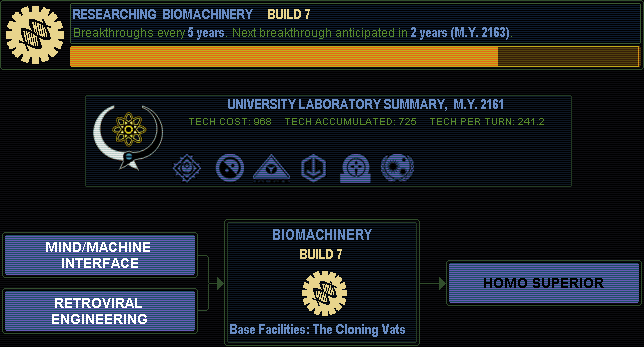
It actually looked like that one turn in Planned would leave me juuust short of finishing Biomachinery tech. But I knew the twenty recycling tanks about to complete would give the labs to make up that remaining margin on this same turn. (Even if that hadn't worked, I could have let the first few bases complete Biomachinery on the following turn, and built the Cloning Vats in a non-HQ base just after the tech completed mid-production-cycle, thus losing only a fractional turn step of booming.)
I nerve-stapled all my existing bases, but had the problem that I was still founding a few new ones that would miss the stapling once back into Free Market. Really the only useful way to manage them was keep them at size 3 for the moment. Then ten turns later, I switched to Planned for one turn again to apply the second round of nerve stapling, and now that included those last ten or so bases which joined in the boom as well.
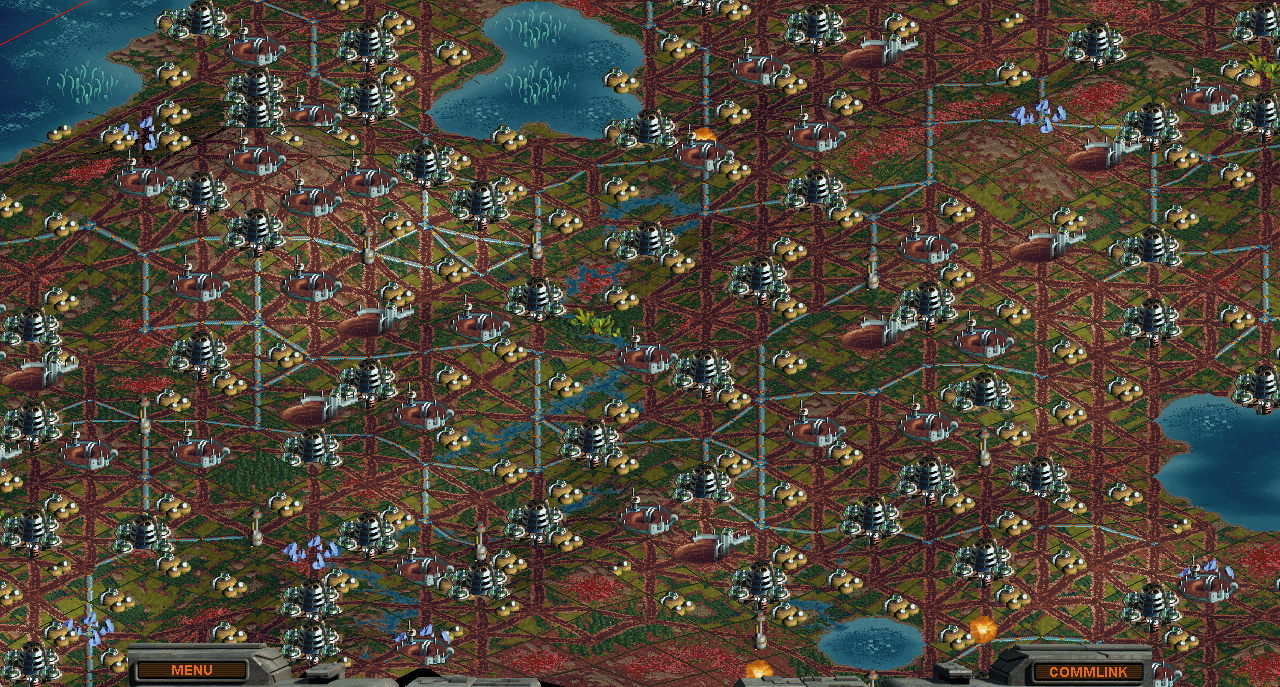
Here's a look at the terraforming, a little bit later after mag-tubes and soil enrichers. Most squares have farms. Every square is rainy by way of the condensors spaced around. Plus some mines and boreholes. The condensors aren't in any planned arrangement or pattern, just the most expedient tile as reachable by formers each time I needed. All this food made the population boom proceed with little stalling.
I was driving all the decisions by the idea of productivity-per-former-turn. I'm really starting to think that's the key metric, more so than productivity per tile or per population. Tiles are not in limited supply, you always have more than you can improve. Former-turns are always limited. So here's how to judge that. A farm is +1 food for 3 former-turns (with Weather Paradigm) which is the readily available baseline. A condensor that would affect only its own tile (from moist to rainy plus its own ×1.5 food effect) yields +2 food for 8 former-turns, not as good as a farm or even some other options. But a condensor that makes even just one adjacent tile rainy comes to +3 food for those 8 former-turns, a better deal than a farm. So I ended up with that patchwork spread of condensors, on roughly one out of every six or so tiles. I had envisioned one on every tile, but that just takes an absolutely unattainable amount of former labor, like my Believers game found in trying to construct an endless energy park.
It was now also good value to clear fungus tiles. If an adjacent condensor had made a fungus tile rainy, then clearing it meant 6 turns of former labor to improve the tile from 0 food to 2, equal efficiency per former-turn as a farm. Then that tile also could be farmed as well.
Soil enrichers followed a little later at Adv Eco Engineering tech. I never mentioned or used them in any of the other games, but they would factor in significantly here. A soil enricher followed exactly the same productivity metric, 6 former-turns for +2 food, when built on a rainy tile with a condensor. (The enricher is another +1 on top of a farm, but the math with a condensor's +50% goes from 3 × 1.5 = 4 to 4 × 1.5 = 6.) Enrichers were not worthwhile without a condensor, half as efficient per former-turn as simply more farms. Quantity of food produced everywhere was my foremost concern; I could convert almost all added food productivity immediately into more population (engineers) by switching tiles around to balance every base at exactly +2 food, including accounting for any new food satellites to be finished each turn.
On rocky tiles I built boreholes where possible, but when not (you can adjust altitude to make a borehole possible, but that costs half again as many former-turns as the borehole itself), I simply did what you're supposed to and built mines. Also the mines were comparatively good relative to boreholes since I actually didn't get around to the tech for energy restriction lifting for quite some time, not until after all the orbital stuff. I was pleased with the mines... but presently I also realized and decided that even rocky tiles could be converted to food by the same metric: to level a rocky-rainy tile is 6 former-turns to go from 0 to 2 food, the same deal, and the tile also ends up as rolling to yield a mineral too. I left existing mines in place but now future rocky tiles would get leveled and farmed.
You'll notice I did not build solar collectors or mirrors, even though they're compatible with farms on the same tiles. Just not productive enough. +1 or +2 energy for 6 former-turns is too poor, when the same labor applied towards food would yield +5 effective energy by way of an engineer specialist.
I also messed around with something I've done fairly little before: sea formers planting kelp. That's actually the greatest yield of all for food-per-former-turn, +2 for just 3 turns, and actually even better than that considering they don't consume a turn to move into the target tile, and even faster again considering kelp also auto-spreads. But a sea former is twice as expensive up front. But it still consumes only one support slot. It might be worthwhile to go with some of these somewhat earlier, although I doubt it would make any noticeable difference on the finish date.
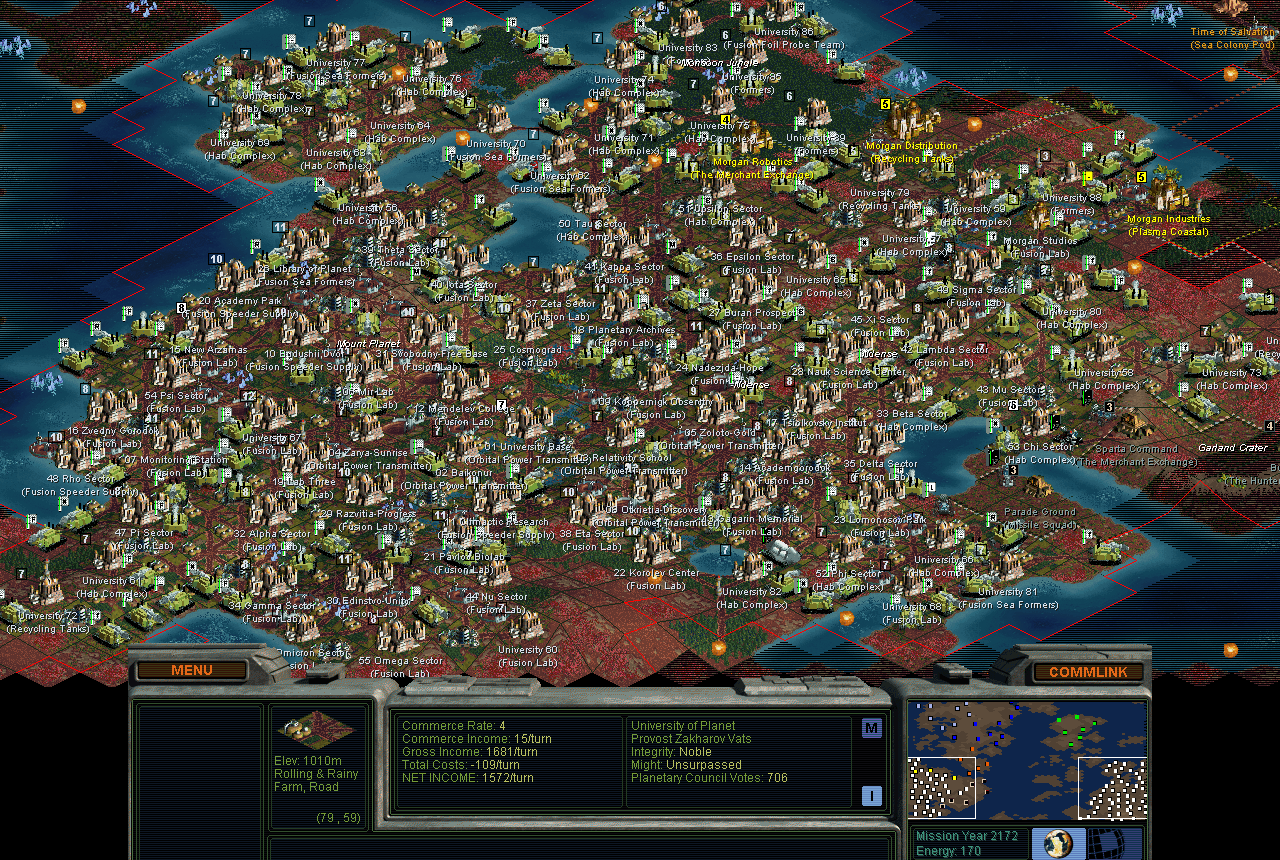
I expanded out to 90 bases total. What I wanted to do was keep expanding outwards forever. In the other games, I've always had the tradeoff that horizontal expansion stops when booming starts, because the SE settings are incompatible; booming requires Democratic but that loses the 10 free minerals and a former support slot, and requires Planned but that sacrifices Free Market's income for rushing more pods. This game was supposed to do all that at the same time with the magic of the Cloning Vats... but it didn't. I didn't make the 150+ bases that I had envisioned, and now I realized why, what the real limiting factor was.
Because the next big breakpoint was orbital satellites for food. There is one build item in the whole game that can drastically exceed the output of anything else. We talk about recycling tanks at 3 units of production for 40 minerals, or something similar with colony pods or crawlers, payback horizons of 10 to 15 turns to recoup such costs. But food satellites can blow away all of that. 240 minerals for two food satellites (halved without aerospace complex) can pay back 80 or more food if you have that many bases - a horizon as short as three turns! And all of that food would immediately go right into booming more population.
The terminus to horizontal expansion is that rushing colony pods costs energy, which becomes a less efficient option compared to food and then energy satellites. What about simply building the colony pods with minerals? That's too slow to be useful: each iteration takes 6 or so turns to build and move the pod, and that's now almost half the entire remaining time for this game!
So for a few turns before Orbital Spaceflight, I stopped rushing colony pods to save the money (about 300/turn) for food satellites and the aerospace complexes to launch them. That fed the population boom, and then Fusion Power came to enable engineer specialists just as the bases came up to the cap at size 7. Then the engineers were making 1200/turn which I continued to spend all on more satellites. I bought six food satellites per turn. Then Advanced Spaceflight arrived, and energy satellites are a similarly good deal: 480 energy to buy two satellites to yield 80/turn, a good payback horizon of six turns, or less considering the multipliers on the produced energy. And also buying satellites takes as input energy that can't be readily converted to labs (the yield from fusion engineers) and emits as output energy that does directly become labs via the slider. I had the count of energy satellites catch up to the food ones, then built both in parallel up to 31 of each (that's a lot, 7440 minerals worth of satellites!) to fully supply all bases at max size 16.
So instead of booming outwards, now it was upwards. With orbital food, it takes surprisingly few condensors to hit those heights. To reach size 14 takes just three condensors! 12 food from those plus 3 from the base square plus 13 from orbital satellites comes to 28 total at size 13, enough to boom to 14. And once a base reached maximum size, it could give the condensors to other bases and work food shortage for a while (growth by booming doesn't even spend food, it stays and accumulates in the box.)
To reach that size requires the hab complex, of course. Any base with a mine or borehole (about half of them) completed its hab complex in good time, roughly as or shortly after the population boom came up to the size 7 cap. Any base without a source of minerals struggled, same as all the bases in my Believers game. For those bases, what I did was take advantage of my second round of nerve stapling when I would spend one turn with Planned's industry discount. I spent about 1000 cash on rushing about half (25) of the remaining (50) hab complexes. That briefly diverted my spending away from satellites, at the one moment when that had a momentary dip in value, when many (about 15) of the food sats were done but one turn before energy sats came available. I didn't quantitatively analyze if that was the best payback for the energy but it felt like it would be.
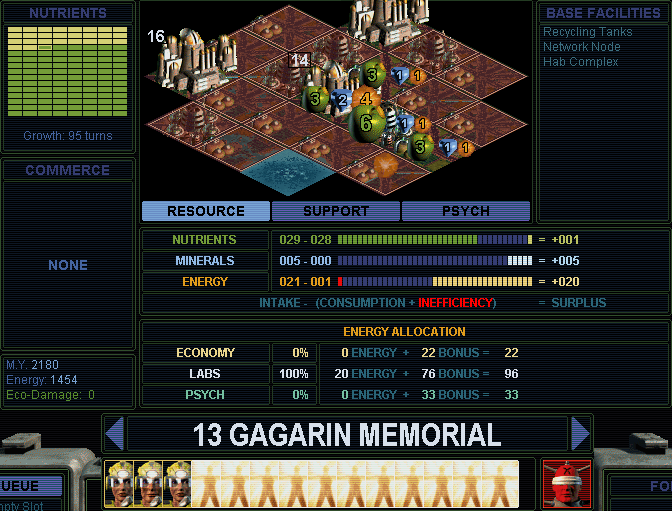
So a typical base looked like this, needing just a few condensors plus the orbital food to reach maximum size and enjoy the yield of all the specialists plus the energy satellites. As a bonus, I basically never saw eco-damage the entire game with the low mineral production; a few bases working boreholes did trigger a few pops but I never got as far as any that spawned worms.
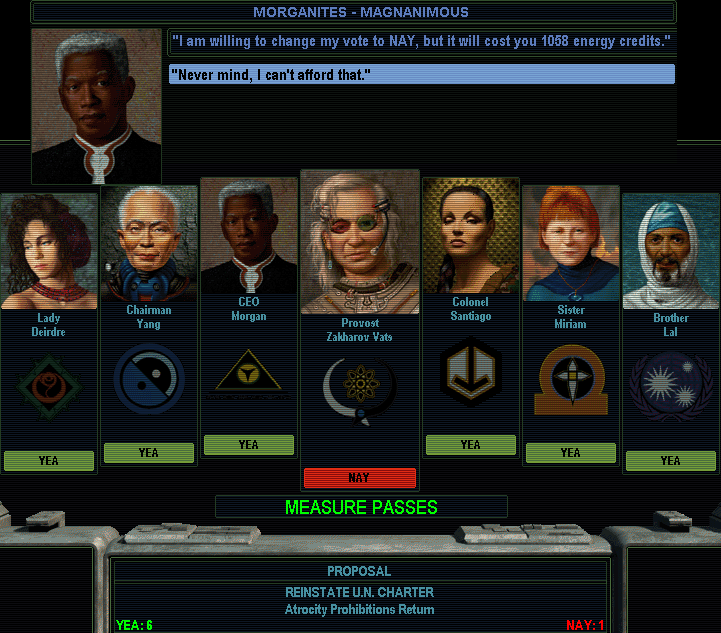
One almost-disaster: the council voted to undo the charter repeal, and nobody would let me buy any votes to stop it! Fortunately that happened just after my second round of nerve stapling, which would stay in effect, and so I'd just have to finish and win before I'd need to do it again. (Also in Council news, or non-news, I forgot to ever try the Salvage Fusion Core proposal.)
Next I'll talk about the SE department. Throughout the population boom, I ran Frontier + Free Market + Wealth with 50% labs slider. Even though I'd stopped founding new bases, the support penalty of Democratic would still hurt every base. I didn't need the Efficiency yet, since 50% sliders was still fine for now, that was just about the right amount of money I needed to keep rushing all those satellites.
Then I started to switch up the SE. After the turn when I dipped into Planned to nerve-staple and rush a bunch of pending hab complexes, I decided that was the time to give up Wealth's industry discount in favor of Knowledge. Then the next turn, I did the Living Refinery secret project (+2 Support on the SE table, at Adv Spaceflight tech), which neatly canceled out the penalty of Democratic so I could finally adopt that. So now at +3 Efficiency and with most of the energy satellites done, that was the time to slam to 100% labs slider for the rest of the game.
And after Advanced Spaceflight and Adv Eco Engineering, I finally cleaned up some loose ends in the tech department: finally got Environmental Economics for energy restriction lifting, then Planetary Economics for the Ascetic Virtues to raise the habitation cap, then also Gaia traded me Centauri Meditation so I could build the X-Dome to speed up fungus work. From there it was the endgame beelines to Cybernetic SE and Transcend specialists as usual.
After hab complexes, bases built fusion labs (the better multiplier compared to a research hospital since it does both economy and labs.) Again, bases with a mine or borehole completed them in somewhat reasonable time, while bases without basically never did. Once all the satellites were done, I had the option to spend my income either on hab complexes in the remaining bases without those, or on fusion labs. The right move was the fusion labs: that raises a base's productivity by 50% immediately, while the hab complex takes 5 turns to boom 50% more population over size 9... and the game won't last another 5 turns!
Here's a nice timeline showing each of the developments and the explosion in labs productivity along the way. To summarize my research pace: it was at about three turns per tech after the PTS, gradually came up to two turns per tech by the time of the Cloning Vats and from there to Orbital Spaceflight and Fusion Power, accelerated to one turn per tech during the population boom, then blew the lid off to multiple techs per turn after energy satellites, Knowledge SE, and max labs slider.
| Year | Effects | Economy | Labs |
|---|---|---|---|
| 2160 | Frontier + Free Market + Wealth, 50% sliders | 230 | 500 |
| 2161 | Planned for one turn for nerve stapling | 80 | 240 |
| 2162 | Free Market, many recycling tanks | 250 | 570 |
| 2163 | First population boom | 300 | 630 |
| 2164 | Some bases at size 5 to enable labs specialists | 300 | 810 |
| 2165 | More labs specialists | 300 | 1000 |
| 2166 | Boom somewhat stalled for food; buy aerospace complexes | 300 | 1130 |
| 2167 | Switch labs specialists to economy; buy first food satellites | 500 | 1000 |
| 2168 | Big boom with satellite food; switch specialists back to labs | 350 | 1600 |
| 2169 | Fusion Power, switch all specialists to fusion engineers | 1180 | 1750 |
| 2170 | 1300 | 1940 | |
| 2171 | Planned again to nerve staple, rush many hab complexes | 1220 | 1700 |
| 2172 | Back to Free Market, first energy satellites | 1550 | 2400 |
| 2173 | More energy satellites, Knowledge SE | 1700 | 3000 |
| 2174 | Democratic, 100% labs slider | 1000 | 4200 |
| 2175 | Ascetic Virtues booming for bases that didn't do hab complex | 1150 | 4700 |
| 2176 | 1350 | 5200 | |
| 2177 | 1600 | 5600 | |
| 2178 | Cybernetic Future Society | 2100 | 7200 |
| 2179 | Transcend specialists, rush some fusion labs | 1500 | 11600 |
| 2180 | More fusion labs, bases with hab complexes rushed in 2171 now at max | 1600 | 12400 |
| 2181 | Labs quadrupler projects in one base | 1600 | 13000 |
| 2182 | Transcendence | ||
As that shows, the endgame compressed more with higher labs productivity than ever before, up to 13000, four full techs per turn. Plus the freebies from Universal Translator and the two late Secrets techs. The tech schedule completed neatly, with the last three coming on the same turn, with no missing-tech holes, and as always I pre-filled the last two bases in production order with 600 and 2000 minerals of upgraded crawlers to switch to Voice of Planet and Ascent to Transcendence all on the same turn.

A last look, although all that changed since the previous overview is base sizes and more terraforming.
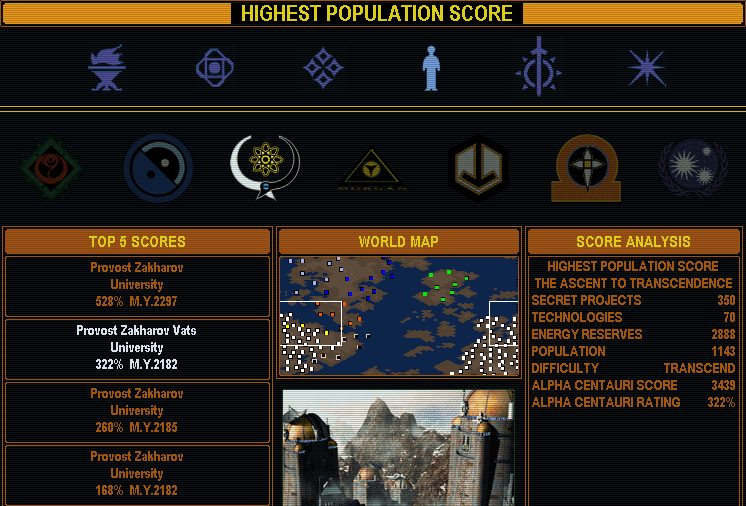
Transcendence victory in 82 turns, 23 faster than Morgan, and actually just six slower on a normal map than my old effort on the super-tiny map. So now I'm satisfied, with a better University writeup than my old original one for speed transcendence. Thanks for reading, and comments and discussion can be held at the Realms Beyond thread here.